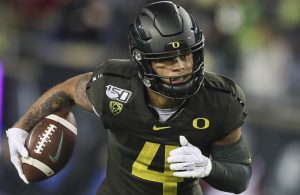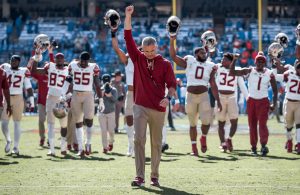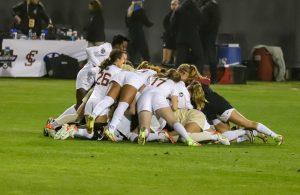- Sunday Seminole Summary: FSU Football Adds Pair of WR Transfers
- Sunday Seminole Summary: FSU Football Exits ESD With Top-15 Class
- Sunday Seminole Summary: FSU Soccer Tops BYU for Third National Championship
- Sunday Seminole Summary: FSU Soccer Advances to National Championship Match
- Seminole Sunday Summary: FSU Soccer Heads Back to College Cup
- Seminole Sunday Summary: FSU Soccer Reaches Sweet 16; Football Tops Boston College
- Seminole Sunday Summary: FSU Soccer Wins ACC, Advances to Second Round of NCAA Tournament; FSU Football Rallies Past Miami
- Seminole Sunday Summary: FSU Soccer Tops Wake on OT to Advance to ACC Final
- Seminole Sunday Summary: FSU Football Crushes UMass for Third Straight Win
- Seminole Sunday Summary: FSU Soccer Stays Perfect with Pair of Wins
FSU Baseball: Postseason Primer
- By Clint Eiland
- Updated: May 31, 2017
 Atlantic Coast Conference
Atlantic Coast ConferenceWe get it. Baseball season is long, the days are hot, and you have more captivating things to worry about it. Of the big three sports on Florida State’s campus, baseball is probably the most difficult one to get in to. Whereas someone with little knowledge of football or basketball can jump right in as a fan and enjoy themselves, baseball requires more commitment and observation.
Do not worry if you have not consistently kept track of FSU baseball throughout their current 2017 season. You can still cheer the team on in the postseason and hope they represent the school well. We here at The Daily Nole will help your fandom with the postseason primer.
Below is quick rundown of what FSU baseball has shown us so far, what it could potentially show us in the postseason, and how in the world the postseason works anyway.
How Does the NCAA Baseball Postseason Work?
Frankly, the more attempts it takes to write it out, the more confusing an explanation becomes. Here’s the best we could do.
The entire postseason operates on a double-elimination system. One loss does not send a team home. Only when a team loses twice in the same round are they officially out of the postseason.
The postseason starts out with 16 regionals. These regionals are composed of four teams each. These teams are generally located in the same area (hence the name). When three teams in the regional are eliminated, the regional winner then faces the winner of another regional.
This match-up is called the Super Regional. There are 16 teams in the Super Regionals, which is comprised of eight best-of-three series. When all is said and done, the eight teams that win those series go to the College World Series in Omaha, Nebraska. These eight teams are then split in to two 4-team pools, similar to the regional. The winners of those two sides will meet in a best-of-three series for college baseball’s ultimate prize.
How Did Florida State Get Here?
It was a bumpy ride to say the least. Florida State started off the season ranked No. 3 in February, and propelled itself to a No. 1 ranking by D1Baseball.com in the middle of March. The Seminoles were 13-3 at that point. That was also where the “wheels fell off” to speak.
After back-to-back losses against Florida and Florida Gulf Coast (good teams) and a series loss against Virginia Tech (bad team), the Seminoles were punished in the rankings with a No. 13 spot. Florida State never really got into the rhythm once those losses happened. It would occasionally impress with series wins over Clemson and FGCU, but then look completely helpless in games against North Carolina and Virginia. The numbers say it all: after the series against the Hokies, Florida State went 19-13 in its next 32 games. That’s the sign of a decent but clearly flawed team.
However, that was not the end of the season. In perhaps the strangest twist yet, Florida State went up to Louisville to face the then No. 2 ranked Cardinals for the last regular season series. It managed to win two games (the third was cancelled) and end the season with a huge series victory over a great team. When the regular season was all said and done, the Seminoles were 35-20 overall and 14-14 in the ACC.
The Seminoles earned the No. 8 seed in the reformatted ACC Tournament and maintained their newfound momentum. In four days, Florida State beat Notre Dame, Louisville, and Duke to reach the tournament final. Once there, the Seminoles roared back from an early 3-0 deficit to defeat the North Carolina Tar Heels, 7-3.
Florida State completed one of the most dramatic late-season turnarounds with its second ACC Tournament championship in three years. The Seminoles were rewarded by being named a regional host. The teams who will join them in Tallahassee include Auburn, Tennessee Tech, and UCF.
What Are Florida State’s Strengths?
Offense is without question Florida State’s best attribute. The Seminoles are hitting at an elite pace against quality pitching, which was not the case until about halfway through the season. They have been on a tear lately, with the Louisville series presenting the most obvious examples. In all other home ACC series combined, the Cardinals gave up 33 runs. In two games against FSU? 20. Players like Quincy Nieporte and Dylan Busby have gotten hot at just the right time. It provides some captivating baseball when they’re in a rhythm.
Also helpful is the depth that FSU has as a team. While it hasn’t always shown it, Florida State has enough serious threats at the plate that any pitcher is rarely able to escape unscathed. This in turn helps FSU show resilience and to never truly be “out” of any game, since all it takes is a few hits in a row to get momentum back on its side.
FSU currently ranks 17th in total runs, 30th in on-base percentage, 18th in overall scoring, and 39th in home runs. By all measures, this is a team that is hoping its bats will carry it through the postseason. Why such a reliance on the offense? Well…
What Are Its Weaknesses?
Pitching. There is practically no other answer that would fit when discussing on-field issues. Florida State has exactly one starting pitcher that it can trust on a game-by-game basis and that’s Tyler Holton. The sophomore from Tallahassee has been absolutely phenomenal this season, garnering 119 strikeouts and only 26 earned runs over 96 innings pitched. His May was especially ridiculous with 26 innings pitched and only four earned runs allowed — a 1.38 ERA.
The problem stems from the lack of quality pitchers behind Holton. Guys like Cole Sands and Andrew Karp constantly flash potential, but then they always seem to have one bad inning where they completely melt down. Head coach Mike Martin and the staff have been forced to play musical chairs with the bullpen, and it is a fairly serious indictment that they were unable to figure out the situation for almost the entirety of the season.
There is reason for optimism, however. Through the first three ACC Tournament games, FSU starting pitchers (Drew Parrish, Holton, and Sands) accounted for 20 2/3 innings pitched, 10 hits, 2 earned runs, and 21 strikeouts. That is a marked improvement from Parrish and Sands’ earlier performances. Perhaps they too are getting hot at just the right time.
Who Should You Keep An Eye On?
As mentioned above, Tyler Holton seems to be the key to any postseason success. When the Seminoles use him will be up to Martin to figure out. Florida State cannot waste its chances whenever Holton is on the mound.
When it comes to hitting, there a few names to keep track of. Jackson Lueck has been a man on a mission recently. He recorded at least one hit in every game from April 29 up until Sunday’s ACC final. He was especially potent in the tournament, getting seven hits and seven RBIs in four games (including the walk-off 2-run home run against Notre Dame). Dylan Busby was right there with him with eight hits and five RBIs.
It would also be remiss to not mention Drew Mendoza as a wild card. Mendoza was an elite prospect that missed the first half of the season with injury, and he’s now into full form after powering the Seminoles to an ACC Championship. He had two home runs and four RBIs on Sunday afternoon.
What Will (Likely) Happen?
It is always difficult to pick against a team that enters the postseason with momentum. Florida State is (mostly) healthy, has home field advantage, and has seen a streak of good pitching. Could this team actually make it to the College World Series like it was expected to at the beginning of the year?
Fans should not expect that.
Florida State has impressive players and has indeed been on a tear ever since the final regular season series against Louisville. But are the weaknesses in pitching actually solved? Or are they just temporarily subdued? Consensus would suggest that Martin is going to put Holton in the second game against whoever the Seminoles face in the regional, especially if they win on Friday night.
If they lost the first game, Holton would be able to propel them to a game two victory and put their season on the line in game three. If they won the first game, Holton would guarantee a Regional Final appearance. But therein lies the problem: it is certainly possible that guys like Parrish or Sands are able to have a good enough game to let the FSU offense win it. Yet no one besides Holton at this point can be trusted. They can advance out of the Regional with that being the case, but if that stays true in the Super Regional, they will be going home early.
Ultimately, it all depends on how much faith one puts into the pitchers behind Holton. If they can be decent and power through the storm, then the College World Series is strong possibility. But that would require a stretch of pitching that the Seminoles have simply not shown the entire season.




You must be logged in to post a comment Login